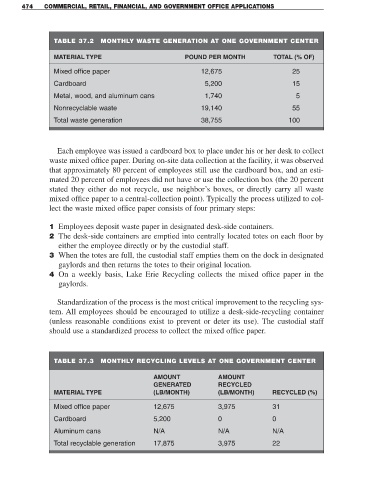Page 496 - Solid Waste Analysis and Minimization a Systems Approach
P. 496
474 COMMERCIAL, RETAIL, FINANCIAL, AND GOVERNMENT OFFICE APPLICATIONS
TABLE 37.2 MONTHLY WASTE GENERATION AT ONE GOVERNMENT CENTER
MATERIAL TYPE POUND PER MONTH TOTAL (% OF)
Mixed office paper 12,675 25
Cardboard 5,200 15
Metal, wood, and aluminum cans 1,740 5
Nonrecyclable waste 19,140 55
Total waste generation 38,755 100
Each employee was issued a cardboard box to place under his or her desk to collect
waste mixed office paper. During on-site data collection at the facility, it was observed
that approximately 80 percent of employees still use the cardboard box, and an esti-
mated 20 percent of employees did not have or use the collection box (the 20 percent
stated they either do not recycle, use neighbor’s boxes, or directly carry all waste
mixed office paper to a central-collection point). Typically the process utilized to col-
lect the waste mixed office paper consists of four primary steps:
1 Employees deposit waste paper in designated desk-side containers.
2 The desk-side containers are emptied into centrally located totes on each floor by
either the employee directly or by the custodial staff.
3 When the totes are full, the custodial staff empties them on the dock in designated
gaylords and then returns the totes to their original location.
4 On a weekly basis, Lake Erie Recycling collects the mixed office paper in the
gaylords.
Standardization of the process is the most critical improvement to the recycling sys-
tem. All employees should be encouraged to utilize a desk-side-recycling container
(unless reasonable conditions exist to prevent or deter its use). The custodial staff
should use a standardized process to collect the mixed office paper.
TABLE 37.3 MONTHLY RECYCLING LEVELS AT ONE GOVERNMENT CENTER
AMOUNT AMOUNT
GENERATED RECYCLED
MATERIAL TYPE (LB/MONTH) (LB/MONTH) RECYCLED (%)
Mixed office paper 12,675 3,975 31
Cardboard 5,200 0 0
Aluminum cans N/A N/A N/A
Total recyclable generation 17,875 3,975 22

